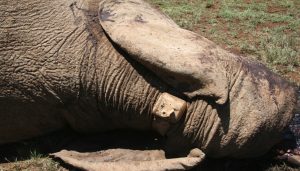
To see an elephant lying on his side in pain is a disconcerting sight. I had become so used to watching these giants wrestle in the mud or eat their way through camp that it was hard reconcile my previous experiences with elephants with the motionless animal in front of me. The only signs of life were his eyes, which darted around cautiously, tracking people as they moved around nearby.
The previous day, we received reports that Nusura, a collared bull elephant in his late twenties, had been observed walking with a limp. His name, which means ‘survivor’ in Kiswahili, was given to him because of the huge scar on his body – evidence of a significant wound from which he had recovered. Our plan was to bring a vet from the Kenya Wildlife Services (KWS) to treat him, but when we arrived we discovered that his condition had greatly worsened overnight. Some time during the night, Nusura had collapsed onto his injured leg, and was now lying in the Isiolo River, too fatigued to move. As we waited for the vet to arrive and decide his fate, I realized that there was a very good likelihood that I was observing the last minutes of Nusura’s life.
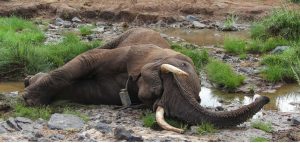
Nusura’s body with tracking collar and both tusks intact
Cherie & Sokotei
Since I arrived in Kenya three weeks ago, three of our study elephants have died from both natural and unnatural causes, but Nusura’s death will be the first one I will actually witness. Cherie was the first dead elephant I heard about, and she died on the day I flew into Nairobi (April 10th). I remember arriving at the Save the Elephant office, and immediately becoming immersed in the drama. Cherie, a 27 year old from the First Ladies family, had finally passed away after a two-week long battle with a twisted colon that had seen her guts rotting away inside her. Save the Elephants kept a close eye on her and called KWS vets in several times, but there was nothing that could be done and in the end she finally succumbed. Her 5 month-old calf, Sokotei, would have died without her. In Kenya, the presence of the David Sheldrick Wildlife Trust gives an alternative. The next morning Sokotei was taken to their orphanage in Nairobi (see an interview with Saba Douglas-Hamilton about Cherie’s death here.
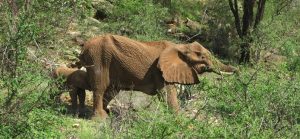
Cherie trying to feed as calf tries to suckle
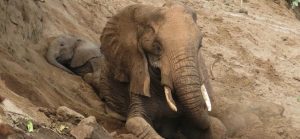
Cherie and Sokotei on the river bank struggling to stay alive
Amayeta
The following week after Cherie’s passing, Amayeta’s tracking collar stopped moving. Amayeta was a young orphan from the American Indians family, who had lost their matriarch to poaching. We found her body near the Ewaso River in a grove of Doum Palms. She also died from natural causes – complications from giving birth to her third calf.
In some ways, knowing that an elephant died naturally tempers the sadness of the situation. If we truly want elephants to be wild creatures, some form of death and suffering is part of the package. However, when an animal is poached and his or her life cut short unnecessarily, then the death is truly a tragic event. On April 28th, poachers outside of Isiolo killed Maua, from the Flowers Family. Following the rains in search of fresh forage, Maua wandered into dangerous territories and paid for that decision with her life.
These deaths remind us that elephants, despite their great stature and intelligence, are just as vulnerable to disease, injuries, and human attacks as other wild animals. As caretakers of these creatures, KWS vets and rangers sometimes have to make difficult choices. After examining Nusura lying on his side and in agony, the vet decided that there was nothing we could do for him except to put him out of his misery. Left alone, Nusura might suffer for another week before finally dying. While elephants must remain wild animals, with all the risks that being one entails, it is difficult not to intervene when we can reduce an animal’s pain. As I listened to the gunshots that finally ended Nusura’s life, I felt relief that his suffering was over.
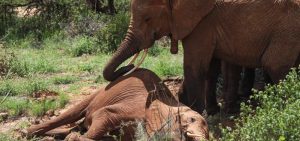
Amayeta’s family and friends visiting her body

